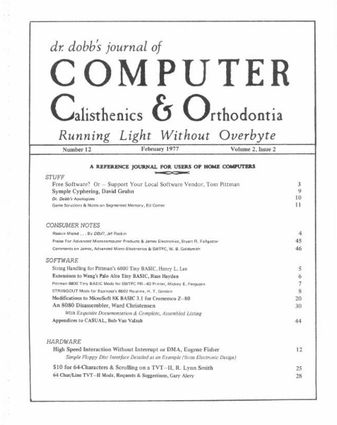
[author : Tom Pittman] #TradeAndLaws
Extract : « [...] Among personal computers there is a software vacuum. Tiny Basic was an attempt to start filling that vacuum. About a year ago PCC started publishing articles entitled "Build Your Own Basic", giving details and general architecture for Tiny Basic, a children’s language conceived by Bob Albrecht. The idea was to get hundreds of hobbyists across the country working and sharing and producing tons of free software. Instead of hundreds, we actually saw only about a half a dozen successful working programs. Why? [...] »
[author : Henry L. Kee] #BASIC
Extract : « Enclosed are modifications to Pittman’s Tiny BASIC version 1.2S. These changes will enable the user to add string handling capabilities to Pittman’s Tiny BASIC. [...] »
[author : Russ Hayden] #BASIC
Extract : « I have added some extensions to Li-Chen Wang’s Palo Alto Tiny BASIC which may be of interest; they include machine language subroutine linkage, string I/O, and memory location examination and modification. These additional statements and functions take approximately 150 bytes; [...] »
[author : Mickey E. Ferguson] #BASIC #Listing #MachineCode
[author : H.T. Gordon] #Listing #Assembly
Extract : « [...] In DDJ Vol. 1, No. 10 (p. 50), Marcel Meier presented a revision of the Espinosa 6502 program STRINGOUT, cutting its length from 64 to 44 bytes and making it relocatable in RAM. The following revision cuts it to 40 bytes, allows location in ROM (or RAM), is compatible with 6502 systems other than the OSI-400 (e.g., KIK-1), and allows selection of a variety of subroutines to work on the character string. [...] »
[author : David Gruhn] #Algorithm #Cryptography
Extract : « [...] To encode a text in a computer, you need to take the bit configurations that represent each character, and substitute in some other bit configurations, using some predetermined set of rules that will allow you to, later, reverse the process; to decode the encoded characters. [...] »
[author : Eugene Fisher] #Interface #Electronic #Listing #Assembly
Extract : « Microcomputer designs don’t require techniques based on minicomputer hardware to achieve high speeds. Though designers often employ speed-enhancing interrupt or direct-memory-access (DMA) techniques borrowed from the mini world, the same improvements can be obtained far more simply. All that’s needed is a microprocessor whose operations can be suspended readily during data transfers. Microprocessors like Intel’s 8080 permit just this kind of solution. [...] »
#BASIC #Listing #MachineCode
[author : R. Lynn Smith] #Electronic #Display
Extract : « I am enclosing details for a conversion I made on my SWTPC TVT-II to allow it to operate in a scrolling mode with 64 character lines. I’ve been using this feature on my TVT for over two months now and find it a marked improvement over the original. [...] »
[author : Gary Alevy] #Electronic #Display
Extract : « [...] I would like to suggest a new approach for DDJ to pursue in the area of software development. Till now, DDJ has set up specifications for languages that can be implemented by its readers. The response in the form of Tiny Basics, and other languages has been wonderful. I propose that DDJ publish specifications for applications programs that would serve as an impetus to program development as did the original specifications for Tiny Basic. [...] »
[author : Ward Christensen] #Listing #Assembly #Programming
Extract : « Editor’s Note: Normally , we would typeset the text portion of an article such as this. However, we are publishing it "as received"(1) to illustrate what can reasonably be expected from a personal computer used for so-called "word processing" using a plain-jane I/O Selectric, and (2) to exhibit a beautifully-prepared manuscript, the likes of which we would be delighted to receive more often.
Enclosed you will find an assembly listing of my disassembler, user documentation, and sample runs. I also have included my symbol table edit routine, which allows you to substitute meaningful labels for the simple Lxxxx (xxxx=hex addr) default ones. I hope you publish it, and your readers enjoy using it. I do not have facilities to distribute machine readable copies (either source or object) in any form other than Tarbell, 187 bytes/sec (Tarbell standard), in a series of source files compatible with the Processor Technology Package I assembler. [...] »
[author : Bob Van Valzah] #BASIC #APL